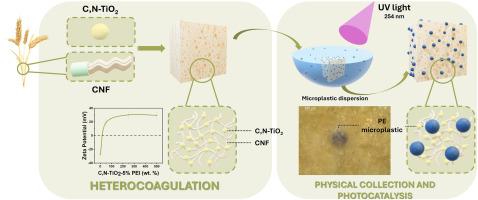含有C,N-TiO2胶体分散在纤维素纳米纤维上的生物基光催化海绵状结构的处理及其微塑料修复
IF 8.4
2区 环境科学与生态学
Q1 ENVIRONMENTAL SCIENCES
引用次数: 0
摘要
本研究提出了一种创新的方法,将高效光催化剂固定在来自农业生物质生物精炼加工的生物基基质上。该策略为木质纤维素组分增加了显著的价值,同时减少了用于水污染控制的微塑料(MPs)光催化中通常需要的光催化剂回收(例如过滤、离心或沉淀)单元操作的数量。采用固定化纤维素纳米纤维(CNF)载体的绿色光催化C,N-TiO2粉末对聚乙烯MPs的脱除进行了研究。所得的海绵状结构(气凝胶)结合了C,N-TiO2的光催化活性和CNF的物理收集能力,以增强对MPs的去除。在低pH和MPs浓度下,CNF-C,N-TiO2在254 nm照射6小时后,MPs脱除率达到18.46%,主要是通过活性氧(ROS)驱动的光催化降解,而不是物理收集。通过MPs表面粗糙度的降低、含C=O键化合物的形成和OH●清除剂的测试,证实了光催化作用。此外,在CNF-C,N-TiO2气凝胶中检测到更小的PE碎片。纯CNF和CNF- p25 TiO2结构的对比分析表明,MP的去除效果有限。这归因于CNF的光解作用,以及CNF- p25 TiO2的光催化和物理收集作用。总的来说,本研究强调了CNF-C,N-TiO2海绵状结构通过光催化和物理相结合的方法去除MPs的潜力,同时也强调了优化反应条件以获得最大效率的必要性。本文章由计算机程序翻译,如有差异,请以英文原文为准。

Processing of bio-based photocatalytic sponge-like structures containing C,N-TiO2 colloidally dispersed onto cellulose nanofibers for microplastic remediation
This study presents an innovative approach for immobilizing a highly efficient photocatalyst on a bio-based matrix derived from biorefinery processing of agricultural biomass. This strategy adds significant value to the lignocellulosic fraction, while reducing the number of unit operations typically required for photocatalyst recovery (e.g., filtration, centrifugation, or sedimentation) in the photocatalysis of microplastics (MPs) for water pollution control. The removal of polyethylene (PE) MPs was investigated using a green photocatalytic C,N-TiO2 powder immobilized on a cellulose nanofiber (CNF) support. The resulting sponge-like structures (aerogels) combined the photocatalytic activity of C,N-TiO2 with the physical collection capabilities of CNF to enhance the removal of MPs. At low pH and MPs concentrations, CNF-C,N-TiO2 achieved 18.46 % MPs removal after 6 h of irradiation at 254 nm, primarily via photocatalytic degradation driven by reactive oxygen species (ROS) rather than physical collection. Photocatalysis was confirmed by MPs surface roughness reduction, formation of C=O bond-containing compounds, and OH● scavenger tests. Additionally, smaller PE fragments were detected in the CNF-C,N-TiO2 aerogel. Comparative analysis of the pure CNF and CNF-P25 TiO2 structures showed limited MP removal. This was attributed to photolysis for CNF, and to photocatalysis and physical collection for CNF-P25 TiO2. Overall, this study highlights the potential of CNF-C,N-TiO2 sponge-like structures for MPs removal through a combined photocatalytic and physical approach, while also emphasizing the need to optimize the reaction conditions for maximum efficiency.
求助全文
通过发布文献求助,成功后即可免费获取论文全文。
去求助
来源期刊

Journal of Environmental Management
环境科学-环境科学
CiteScore
13.70
自引率
5.70%
发文量
2477
审稿时长
84 days
期刊介绍:
The Journal of Environmental Management is a journal for the publication of peer reviewed, original research for all aspects of management and the managed use of the environment, both natural and man-made.Critical review articles are also welcome; submission of these is strongly encouraged.
 求助内容:
求助内容: 应助结果提醒方式:
应助结果提醒方式:


